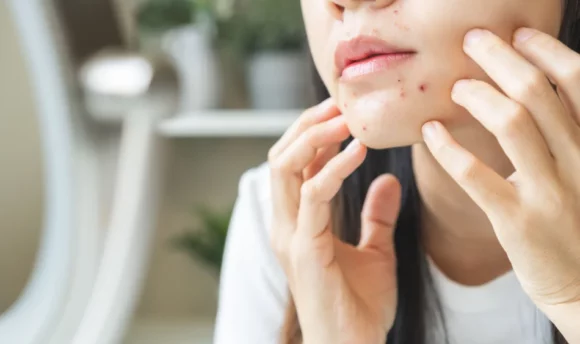Skin Care 101: Building A Routine
Ready to have the skin of your dreams? We’re here to help you build the perfect skin care routine.

Achieving healthy, glowing skin starts with a well-rounded skin care routine tailored to your unique needs.
Whether you’re new to skin care and need help building a regime from scratch or want to refine your routine, this article will guide you through the essential steps and expert tips for a successful skin care journey.
Keep reading to discover how to identify your skin type, select products to help you have the skin of your dreams, and create a simple yet effective daily routine.
How to Start a Skin Care Routine?
When starting a new skin care routine, the first step is identifying your unique skin type (oily, dry, combination, or sensitive) and specific concerns (acne, aging, hyperpigmentation).
If you’re not sure what skin type you have, the following guide will give you tips for figuring it out:
- Oily: Oily skin is characterized by a shiny or greasy appearance, especially on the forehead and nose (also known as the t-zone), enlarged pores, and acne breakouts.
- Dry: Dry skin often feels tight, especially after cleaning or exposing it to water. It often has an uneven texture and may be flakey or peeling, especially on the cheeks, forehead, and chin.
- Sensitive: People with sensitive skin often experience itching or irritation after using a new skin care product and are prone to redness.
- Combination: The most common type, people with combination skin deal with both dryness, usually around the cheeks and eyes, and an oily t-zone.
Identifying your skin type will make it easier to pick out products specifically designed to help you reach your unique skin goals. Some of these might include cleansers, toners, serums, moisturizers, face masks, and under-eye creams if your goal is to prevent and treat wrinkles.
If you have specific skin concerns that seem to never go away no matter what products you use, consulting a dermatologist for a personalized routine may be just what you need.
With or without professional help, you can create a skin care routine at any age to improve the overall appearance of your skin and prevent premature aging. Creating this routine has to be neither complicated nor costly.
That being said, your routine should always include the following three components:
- Cleanse
- Treat
- Moisturize
Now, let’s take a look at what your basic morning and evening routine should look like.

Basic Morning Skin Care Routine
Below, we’ll provide you with recommendations for each step of your skin care routine, including the best products for you based on your unique type of skin.
#1 Cleanser
Starting with a morning cleanse gives you a clean slate on which to apply products and makeup without worrying about clogging your pores.
You may choose to use an exfoliator in the morning to aid in the removal of dead skin cells and unclog pores, but exfoliators can be very abrasive and leave your skin irritated after use; it’s best to use them only once or twice per week.
Aside from that, it’s important to use a cleanser that’s made specifically for your type of skin:
- Oily: A gentle foaming or gel cleanser will wash away excess oil and dirt without stripping the skin of its natural moisture. Cleansers with salicylic acid or glycolic acid are great for preventing clogged pores.
- Dry: Cleansers with creamy or milky textures tend to be more gentle for dry skin. You may also look for cleansers with moisturizing ingredients such as glycerin, hyaluronic acid, or natural oils like jojoba oil or almond oil to help lock in moisture. Consider cleansing the skin using only water in the morning to avoid stripping the skin of its natural oils.
- Sensitive: For sensitive skin, it’s important to use cleansers with limited ingredients to reduce the risk of a poor reaction. Hypoallergenic and fragrance-free cleansers are the best option for this type of skin.
- Combination: Oil-free and gel-based cleansers work best for combination skin. These kinds of cleansers don’t strip the skin of its natural oils, which is important for preventing excess oil production in the t-zone and dryness in other areas.
#2 Toner
The purpose of a skin toner is to remove any leftover traces of dirt, makeup, or any other impurities still on the skin and to balance the skin’s pH. They are applied after cleansing and before moisturizing and help prepare the skin for the next steps of your routine.
Although it’s not essential to include a toner in your routine, it is a simple step that can create a noticeable impact on skin brightness and your overall complexion, so it’s well worth the investment.
Here are some ingredients for you to look out for, depending on your skin type:
- Oily: Toners with mild astringents, such as witch hazel or tea tree oil, can prevent oil production and reduce inflammation. Toners with salicylic acid are another great option for reducing the production of facial oils.
- Dry: Hyaluronic acid and glycerin are two ingredients that can help you lock more moisture into dry skin. For irritated skin, aloe vera and rose water can be incredibly soothing.
- Sensitive: Gentle toners with mild and natural ingredients, such as spring water and essential oils, or those formulated with ingredients like zinc sulfate, can help soothe sensitive skin.
- Combination: Toners with infusions of green tea, vitamin C, and vitamin E provide hydration to dry areas while helping regulate oil production in the t-zone.
#3 Serums
Serums are designed to help you deliver powerful doses of concentrated ingredients directly where they’re needed. Whether your skin goals include reducing signs of aging, preventing dark spots, or improving your overall complexion, you can find a serum to help.
A vitamin C serum has long been considered the gold standard and an essential step in every morning routine, regardless of your skin type. It’s lightweight and full of antioxidants which help prevent signs of aging and protect your skin from free radicals from air pollution.
Whether you have oily, dry, or sensitive skin, choosing a skin care product based on your unique skin type will help you maximize its benefits:
- Oily: Lightweight and non-greasy serums help to hydrate skin while still controlling excess oil production. Serums with niacinamide can improve skin’s overall appearance by removing dead skin cells, while hyaluronic acid can deliver lightweight moisture.
- Dry: For dry skin, a serum with rosehip oil can provide essential fatty acids and antioxidants needed to nourish and hydrate the skin. Vitamin E and ceramide are two ingredients that strengthen the skin’s natural barrier while also delivering hydration.
- Sensitive: To help soothe sensitive skin, consider serums with gentle ingredients like tiger grass, chamomile, and aloe vera.
- Combination: Serums designed to hydrate skin without clogging pores or causing excess oil production include ingredients like niacinamide, green tea, and vitamin C.
#4 Moisturizer
Face creams are designed to hydrate the skin and protect it from environmental stress. Although you can use the same moisturizers in the morning and evening, they are formulated with different ingredients and designed to serve very different purposes.
Daytime moisturizers tend to be lightweight, easily absorbed into the skin, and a suitable base for subsequent makeup application. Many of them also contain ingredients to protect the skin from UV and free radical damage.
The following list will give you a better idea of the daily moisturizer that best suits your unique skin:
- Oily: Most gel-based moisturizers have a water base instead of an oil base. Because of this, they don’t clog pores and do a better job of providing hydration without being heavy and greasy, perfect for anyone who struggles with oiliness.
- Dry: Ceramide moisturizers can help replenish slightly damaged and dry skin, while moisturizers with oatmeal or shea butter are better for use during winter and nourishing itchy or irritated skin.
- Sensitive: Look for hypoallergenic and alcohol-free products with simple ingredient lists to avoid irritation. Aloe vera and avocado oil moisturizers help calm sensitive skin and reduce redness.
- Combination: Oil-free moisturizers are also a good option for combination skin, as they won’t contribute to an oily t-zone while still providing hydration where it’s needed.
#5 Sunscreen
Whether you decide on a moisturizer with built-in UV protection or apply sunscreen after your daily moisturizer, sun protection is a must for healthy skin.
Though it may not seem as important to protect the skin from UV rays during the winter, we can still experience a great deal of damage during the colder months, so broad-spectrum sunscreen is something that should be worn year-round.
In addition to wearing chemical and physical sunscreens – which we will explain in greater detail below, it’s also a good idea to wear hats to shield your face and neck from the sun when you plan on spending long hours exposed to the sun.
- Chemical sunscreen: Chemical sunscreens typically include ingredients like avobenzone, octinoxate, octisalate, and oxybenzone and are designed to penetrate the top layer of the skin to absorb UV rays. Their lightweight formulas and transparent textures make them easy to apply and give them a non-greasy feel.
- Physical sunscreen: Physical sunscreens contain natural mineral ingredients like zinc and titanium oxide. They sit on top of the skin and act as a physical barrier by reflecting UV rays away from the skin. Mineral sunscreens tend to be more expensive, have a heavier and greasier feel, and can leave behind white residue after application. However, they have the added benefit of being a more natural product, not causing harm to sea life, and being less irritating for sensitive skin.
Basic Night Skin Care Routine
The following nighttime skin care routine will set you up with everything you need to help you improve your skin health while you sleep.
#1 Cleanser
After removing your makeup using wipes or makeup remover on a cotton pad, it’s time to cleanse away any remaining impurities. You can use the same cleanser for both your morning and nighttime routine.
#2 Toner
You can use the same toner in both your morning routine and evening routine to further cleanse and balance your skin before applying serums. While this step isn’t necessary, it is recommended.
#3 Serums
Some serums are formulated for both day and night, like hyaluronic acid, making it a great option for anyone wanting to stick with a single serum for both their morning and night routine.
However, some serums are specifically formulated for night use.
These serums are generally heavier and more concentrated than those used during the day and usually contain active ingredients like retinoids and peptides that help repair and regenerate skin overnight.
Retinol serums have been shown to improve cell turnover and enhance collagen production, helping to reduce fine lines and wrinkles.
They are many people’s go-to evening serum since they reduce signs of aging and can help with acne but can leave the skin sensitive to sunlight exposure when worn during the day.
Serums containing ingredients like glycolic acid, salicylic acid, and some citrus fruits can also increase skin sensitivity, making them better options for your night routine.
Pro tip:
Layering serums can help you glean the benefits of two products at once, but not all ingredients play nice with each other.
Here are some products you should avoid wearing at the same time:
- Retinol or retinoid and vitamin C
- Vitamin A or retinol and glycolic acid
- Retinol or retinoid and salicylic acid
- Two products with the same active ingredients
#4 Spot treatment
Different spot treatment products can be used to help you get rid of acne overnight and treat dark spots and blemishes. They can be used morning and night and should be applied after your daily moisturizers.
Since each skin type has varying needs and sensitivities, it’s important to find the right fit for you:
Oily: The main concern of individuals with oily skin is acne breakouts. For this reason, spot treatments with ingredients like benzoyl peroxide or salicylic acid are the best fit since they help unblock and clean out blocked pores.
Dry: Since harsher chemicals like benzoyl peroxide can dry out and irritate the skin, spot treatments with sulfur or tea tree oil are gentler alternatives for treating acne.
Sensitive: For sensitive skin, it’s best to use spot treatments with gentle and non-irritating ingredients like aloe vera, chamomile, or green tea extracts.
Combination: Spot treatments with more balanced formulas that can help soothe inflammation while also targeting acne-causing bacteria are the best option for combination skin.
#5 Moisturizer
Moisturizers are a skin care product that should be formulated specifically for use in the morning and at night, as they each serve a specific purpose.
Unlike morning moisturizers which are lightweight and protective, nighttime moisturizers are thicker and designed to deeply moisturize and repair, helping you get healthy skin in your sleep.
You can use the same product recommendations outlined earlier to help guide your choice, simply looking for a nighttime-specific product, which should be more focused on repair.
Depending on your goals for your skin care routine, you may also want to use a firming face cream or a moisturizer with collagen at night to reduce the look of fine lines and wrinkles.
That being said, you don’t necessarily have to use two different moisturizers. If you’re trying to simplify your routine or don’t have a huge budget for skin care, you can definitely get away with using your morning moisturizer for your evening routine.
#6 Face oil
Facial oils offer a range of benefits that help keep your skin healthy, from protecting it by locking in moisture to improving texture for smoother skin.
If you are looking to prevent puffiness for a more sculpted look, you may also choose to use facial oils in combination with a gua sha, a tool that is used to massage the face in order to release muscle tightness.
Some popular oil options that you can use, regardless of your skin type, include jojoba oil, rosehip oil, and hemp seed oil, all of which are lightweight and nourishing.
Weekly Skin Treatment
In addition to the skin care basics outlined in the previous sections, doing these treatments on a weekly basis will help boost the benefits of your skin care routine.
Exfoliation
As previously mentioned, exfoliating is something that should take place no more than 1–2 times per week.
Though exfoliating leaves your skin feeling soft and helps to unclog pores, exfoliating too often can disrupt the skin’s protective barrier, leading to skin irritation and potential acne breakouts.
Product-wise, you have quite a few options, including store-bought exfoliating scrubs, clay masks and strips designed to extract dirt from the pores, chemical exfoliants, and DIY options with natural ingredients such as sugar, salt, or coffee grounds.
Hydrating masks
Hydrating masks are a great option for all skin types. They can be especially useful for locking in moisture during the drier months of the year to help keep skin healthy and contribute to more supple-looking and smoother skin.
There are a number of different masks for you to choose from, including sheet masks, gel masks, cream masks, sleeping masks, hydrogel masks, and DIY masks that you can make with things like avocado, yogurt, and honey.
Tips for Healthy Skin
Besides following a morning and night skin care routine, you can also take extra steps to keep your skin healthy and looking its best:
- Eat a healthy diet: If you want to trade breakouts for radiant skin, avoid processed foods and prioritize eating nutrient-dense and antioxidant-rich foods.
- Don’t smoke: Smoking can lead to premature aging by breaking down the skin’s collagen and elastin and introducing free radicals into the body.
- Stay hydrated: To prevent dryness and keep your skin looking supple, aim to drink a gallon of water and natural fruit/vegetable juices per day.
- Use sun protection: Sun exposure can cause wrinkles and hyperpigmentation (dark spots). Incorporate broad-spectrum sunscreen into your morning routine, especially during summer.
- Avoid hot water: Rinse your face with warm instead of hot water to prevent the stripping of your face’s natural oils.
- Moisturize daily: Especially important during the cold and dry months, daily moisturizing strengthens the skin’s protective barrier and helps prevent dryness.
- Get adequate sleep: Getting 8–10 hours of sleep can benefit your skin in a variety of ways, including reducing inflammation, balancing hormones, and increasing collagen production.
- Manage stress: Too much stress triggers the release of hormones like cortisol, which is known to increase skin oil production, leading to clogged pores.
- Exercise regularly: Helpful in managing stress, increasing the production of collagen, and kickstarting the body’s natural detox process.
- Avoid touching your face: To prevent the transfer of bacteria and oils from your hands to your face, try to limit how much you touch your face during the day.
- Get professional help: Whether it’s for regular facials or to treat hormonal acne, don’t be afraid to seek professional help in treating your unique skin issues.
- Give it time: It can take anywhere from 1 to 6 months to experience lasting changes from a new skin care routine. Take advantage of holistic lifestyle changes and use a new skin care product for at least one month before making a switch.
A Word From a Dermatologist
Starting a skin care routine is essential for radiant, healthy skin and starts with identifying your skin type by noticing oily t-zones, dry cheeks, or the combination of dry and oily areas of the face.
Cleansing your skin should always be your first step, followed by water-based treatments such as serums to improve absorption and finishing with more oily and moisturizing products to lock in hydration.
It’s important to include at least SPF 30 sunscreen as a part of your morning routine, even during the winter, as protecting your skin from sun exposure is essential to prevent dark spots and other signs of premature aging.
Avoid over-exfoliation, which can cause irritation, and never underestimate the effect that other factors such as a balanced diet, hydration, and quality sleep can have on overall skin health.
FAQs
You don’t need to spend much time or money on your skin for it to glow. Instead, use a quality cleanser and moisturizer, and focus on healthy lifestyle changes like staying hydrated, getting adequate sleep, and eating a well-balanced diet.
Start by reading the ingredients. You want skin care products with a simple ingredient list that is free from harmful chemicals. Also, pay attention to your skin type and look for products made by reputable beauty brands with dermatologist recommendations.
Start with a gentle cleanser to remove makeup and oil. Then apply your water-based products: first, a toner (optional), then a serum, and finally, a moisturizer. Don’t forget to apply UV protection as you go through your morning routine.
Conclusion
Starting a skin care routine can feel intimidating, but the truth is, most routines follow the same set of steps. Once you know your skin type, the only thing standing between you and healthy skin is finding the right products.
If you feel as though your skin care routine isn’t working for you, try consulting a dermatologist for personalized advice and tailored routines. And most importantly, remember that healthy skin takes time, and consistency is the key to change.

















































 Select your language:
Select your language: 








